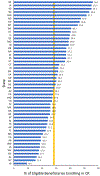Tracking Cardiac Rehabilitation Utilization in Medicare Beneficiaries: 2017 UPDATE
- PMID: 35135961
- PMCID: PMC10865223
- DOI: 10.1097/HCR.0000000000000675
Tracking Cardiac Rehabilitation Utilization in Medicare Beneficiaries: 2017 UPDATE
Abstract
Purpose: This study updates cardiac rehabilitation (CR) utilization data in a cohort of Medicare beneficiaries hospitalized for CR-eligible events in 2017, including stratification by select patient demographics and state of residence.
Methods: We identified Medicare fee-for-service beneficiaries who experienced a CR-eligible event and assessed their CR participation (≥1 CR sessions in 365 d), engagement, and completion (≥36 sessions) rates through September 7, 2019. Measures were assessed overall, by beneficiary characteristics and state of residence, and by primary (myocardial infarction; coronary artery bypass surgery; heart valve repair/replacement; percutaneous coronary intervention; or heart/heart-lung transplant) and secondary (angina; heart failure) qualifying event type.
Results: In 2017, 412 080 Medicare beneficiaries had a primary CR-eligible event and 28.6% completed ≥1 session of CR within 365 d after discharge from a qualifying event. Among beneficiaries who completed ≥1 CR session, the mean total number of sessions was 25 ± 12 and 27.6% completed ≥36 sessions. Nebraska had the highest enrollment rate (56.1%), with four other states also achieving an enrollment rate >50% and 23 states falling below the overall rate for the United States.
Conclusions: The absolute enrollment, engagement, and program completion rates remain low among Medicare beneficiaries, indicating that many patients did not benefit or fully benefit from a class I guideline-recommended therapy. Additional research and continued widespread adoption of successful enrollment and engagement initiatives are needed, especially among identified populations.
Copyright © 2022 Wolters Kluwer Health, Inc. All rights reserved.
Conflict of interest statement
The authors declare no conflicts of interest.
Figures

References
-
- Ades PA. Cardiac Rehabilitation and Secondary Prevention of Coronary Heart Disease. N Engl J Med. 2001;345:892–902. - PubMed
-
- Lavie CJ, Milani RV. Cardiac Rehabilitation and Exercise Training in Secondary Coronary Heart Disease Prevention. Prog Cardiovasc Dis. 2011;53:397–403. - PubMed
-
- Funahashi T, Borgo L, Joshi N. Saving Lives with Virtual Cardiac Rehabilitation. N Engl J Med. Catalyst https://catalyst.nejm.org/doi/full/10.1056/CAT.19.0624. Accessed March 1, 2021. - DOI
-
- Thomas RJ, Balady G, Banka G, et al. 2018 ACC/AHA Clinical Performance and Quality Measures for Cardiac Rehabilitation: A Report of the American College of Cardiology/American Heart Association Task Force on Performance Measures. J Am Coll Cardiol. 2018;71:1814–1837. - PubMed

